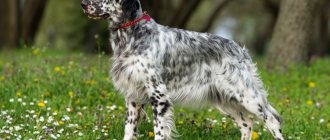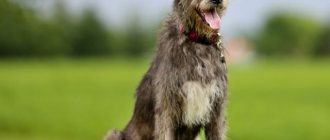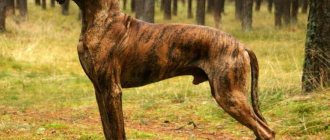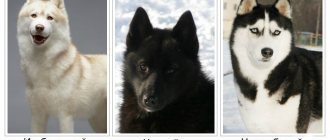Breed characteristics
| Short description | |
| Origin: | England |
| Conditions of detention: | In a city apartment, in a country house with a garden |
| Purpose: | Hunting |
| Color: | Chestnut, brown-red |
| Wool length: | Long, 7 – 8 cm |
| Adult dog size: | The height of females is 55 – 62 cm, the height of males is 58 – 67 cm. The weight of females is 25 – 29 kg, the weight of males is 29 – 32 kg |
| Average life expectancy: | 12 – 15 years |
| Walk: | Needed, 2 times a day |
| Physical exercise needs: | High physical activity needs (regular or daily exercise for more than 3 hours per day) |
| Fédération Cynologique Internationale (FIC) classification: | Group 7 “cops”; Section 2 “British and Irish pointers and setters” |
| Puppy price: | 20 thousand rubles |
Description, appearance of the Irish Setter
If you are not familiar with the breed, just watch the commercial for Chappi food, where the setter is featured in the leading role. You will remember his aristocratic appearance, long, intelligent muzzle, leisurely movements and bright red shiny fur.
Breed standards
The latest standard was approved by the FCI in the spring of 2001 and defines the setter as a racing, athletic dog with balanced proportions. Kindness, affection, insight, intelligence, energy and devotion prevail in character.
This is interesting! Height at the withers: females – 55-62 cm, males – 58-67 cm. Long and dry head with a developed occipital protuberance. The transition from the forehead to the muzzle, like the brow ridges, is well defined. The moderately deep muzzle ends in a dark brown/black nose.
The jaws are equal in size and exhibit a scissor bite. The eyes are medium-sized, with dark hazel or dark brown irises. The ears are medium-sized, drooping, low-set and close to the head.
The neck is muscular and moderately long. The chest is deep, moderately narrow in front. The loin is slightly convex and muscular. The front legs are sinewy, the hind legs are muscular and elongated. Small paws with strong toes tucked into a ball. The tail is proportional to the body, set low, strong at the base, tapering towards the end. It is usually kept on the line of the back or slightly lower.
The undercoat is dense, but not thick . Guard hairs of different lengths and densities. The hair on the head (including the muzzle and front parts of the paws) is the least long. The body is covered with soft and thick hair of medium length. The feathers (on the ears, paws, underline and tail) are smooth, long and silky. Hair grows between the toes. The fur color is rich: from chestnut to almost red. There may be white lines on the muzzle, chest and toes.
When running, the setter holds its head high, bringing its front legs forward and pushing off with its hind legs with great force. Both crossing of limbs and their deviation from straight-line movements are not allowed.
Irish Setter Personality
The willfulness of the breed manifests itself when it is taken over by the hunting instinct, embedded deep in the genes. On every walk, the dog will eagerly track down potential game, breaking off the leash and running away from the owner.
That's why you must teach your furry friend basic commands, the most difficult of which is the "come to me" command. The reaction to it should be unquestioning and instant. You may need the help of an experienced dog trainer.
The setter's activity is relieved by long walks (preferably in open areas). When the “come to me” command is executed perfectly, you can move on to walks in the park and forest.
This is interesting! Setters are recommended for agility, coursing, freestyle, frisbee and swimming. A game of fetch will be very organic: the dog loves to fetch thrown objects. It is better to exclude high jumps.
Often, a setter, getting into the excitement of the hunt, gets excited and becomes aggressive. In this case, the dog is shamed and (if necessary) lightly slapped on the rump with a rolled-up newspaper. Hitting the animal with your hand or leash is prohibited. A well-fed and well-fed Irish Setter becomes a calm and loving member of your family. Setters are very good-natured with children.
Lifespan
Like many representatives of the canine tribe, the Irish Setter lives from 12 to 15 years . If you take proper care of it, feed it healthy food and monitor its health, its lifespan can increase by another five years.
It may be interesting: How many years do dogs live?
History of the origin of the species
This dog breed was first mentioned in the 16th century. Irish Setters are distant relatives of breeds such as the Bloodhound and Irish Spaniel . It is known that the first breeders tried not to communicate with each other due to fierce competition, so this breed has many varieties that differ significantly from each other in color and body structure.
The breeders initially set themselves the goal of breeding an animal that would behave easily and naturally among dense bushes, which is why the setter has a hard undercoat and elastic paw pads. Also, dog breeders have worked for a long time to ensure that setters are not afraid of water and loud shots.
History of the breed
Setters are a group of long-haired breeds of hunting pointers. There are English, Irish, Scottish and red-white representatives, which have a number of external differences.
The word Setter itself is translated in English as “crouching”. The breed was named Irish because red setters were first bred in Ireland.
The breed appeared long before the adoption of the first standard in 1886 and until that time no systematic records were kept. Presumably the blood of such ancestors flows in the veins of the “Irish”:
- setting spaniels;
- pointers;
- Irish water spaniels;
- bloodhounds;
- English setters.
The first mention of the breed dates back to around the 18th century. They are about a breeder named Maurice O'Connor, who leased vast areas to train his "red dogs with traces of white."
Important! Until the 19th century, red and white-red setters were considered one breed, but after the introduction of standards they were separated into different breeds.
Irish Setters were first exhibited in 1859. This and subsequent exhibitions played a significant role in the development of the breed. Since this time, pedigree lines can be more or less clearly traced.
Distinctive features
This animal is a real aristocrat.
You can recognize an Irish Setter by the following distinctive features::
- Ears – low and deep set, turned forward;
- Tail – widens towards the base, narrows towards the tip, smooth, covered with hair in adult dogs;
- Eyes – brown, tonsil-shaped;
- The body is thin, elongated, the withers are almost invisible;
- Color – red, red-brown;
- The coat is long, with a thick undercoat;
- The nose is black, mobile, the nostrils are large.
You can also recognize this breed by its smooth, leisurely movements. But when the dormant hunting instinct awakens in the animal, the slowness instantly disappears.
Characteristics and standards
The Setter breed has a light, slightly elongated body and long legs. This structure allows it to develop high speed, which is a definite advantage for hunting. The size allows us to call the dog large, but not massive. The main characteristics of this breed include:
- weight – 35 kg;
- the height at the withers of an adult male varies from 58 to 68 cm, females from 55 to 62 cm;
- jaw scissor bite, without gaps;
- nose with wide nostrils, color from hazel to black;
- the muzzle is square, elongated;
- the ears are soft, medium in size, hanging;
- the brow ridges are strongly pronounced, the skull itself is rounded with a clear occipital protuberance;
- medium-sized, almond-shaped eyes;
- the neck is short, with pronounced muscles, without sagging;
- the chest is narrow, the ribs have a noticeable bend line;
- the paws are long, with strong muscles.
The dog's fur deserves special attention. It is thick, medium hard. The length of the hair is uneven, on the muzzle and the front side of the paws it is much shorter than on the tail, behind the ears and on the chest. The undercoat is dense, which allows the dog not to freeze at sub-zero temperatures.
The representative of the Setter breed has a lean, slender figure without an ounce of excess weight. He has a meaningful, intelligent look and graceful gait.
Photo of an adult dog
Photos of puppies
Features of character and behavior
This dog is distinguished by the habits of an aristocrat and a high intellectual level . Also, the Irish Setter is very independent, so during training it is very important not to force the animal.
It is useless to force this dog to do anything, so the main task of the trainer is to give the animal a positive incentive.
The Irish Red Setter has long been loved by domestic dog breeders due to its bright color and good-natured, calm character. Unlike other tall hunting dogs, he weighs very little and is not obese.
The main distinguishing features of the breed are its rich brick-red color, long thick hair, and large floppy ears. The animal is easy to train, but the red setter is a poor “guardian”: the animal welcomes strangers and is never the first to show aggression.
- The dog is easy to care for and shedding goes unnoticed. The Red Setter does not have the characteristic “dog” smell. No haircut is required; washing your pet once every 10-12 days . Care for the eyes and ears requires special attention.
- The animal is also susceptible to infectious diseases. Therefore, it is very important to strictly follow the vaccination schedule. Coat care requires great attention, especially during the molting period.
- When feeding a dog, it is very important that the diet be rich in vitamins and minerals , so it is recommended to give preference to commercially produced food for dogs that are highly physically active.
Advantages
Before getting an Irish Setter, you need to weigh the pros and cons, since this dog is not suitable for everyone. Among the undoubted advantages of the breed, the following should be noted:
- Easy to care for;
- Activity and ebullient energy;
- High level of intelligence. Setters are easy to train and easily learn basic commands;
- Spectacular appearance. This is especially important for those owners who dream of raising a champion dog, a winner of exhibitions;
- Peaceful, calm disposition, complete absence of aggression.
If the animal is regularly walked and fed well, the dog will always be calm and friendly. Improper maintenance and poor care can provoke aggression.
Flaws
Despite the obvious advantages, this breed also has serious disadvantages. The following can be distinguished:
- Due to the peculiarities of the anatomical structure of the ears, people often suffer from otitis media and suffer from ear mites;
- Sensitive to any changes in the usual diet, susceptible to stomach and intestinal disorders. Setters should never be overfed, otherwise the animal may die from volvulus;
- During sexual activity, as well as during hunting, sometimes it becomes uncontrollable;
- The freedom-loving and wayward setter does not understand the “come to me” command well;
- Pedigree puppies are quite expensive.
It should also be noted that the animal does not feel well if it is not walked and exercised enough. There is no way to lock a setter “within four walls .
Training and education
Irish Setters are not easy to train. This breed has its own characteristics in training. In any case, you must take an obedience course.
Submitting a dog doesn't always work. The principle of complete submission of the Irish Setter to the owner is an outdated method. This theory was formulated based on observations of packs of wild wolves, but they were kept in captivity and, of course, experienced stress. The stress condition forced wolves to show aggression towards each other, but in the wild they do not show aggression to each other - they live together and interact with each other. You need to perceive yourself as the more experienced and mature member of the pack, who is responsible for guiding the new member (Irish Setter puppy) and teaching him good behavior, as well as correcting him if necessary. It is important to remember that Irish Setter puppies learn a lot on their own. They are very inquisitive, love to explore new territories and, of course, experiment. Puppies tend to repeat actions they enjoy (like playing with a toy). They do not repeat actions that cause them pain (for example, destroying a nest and getting bitten). If your Irish Setter puppy misbehaves, ignore him and praise him when he does the right thing. Reward your puppy for following commands and good behavior. Do not neglect these tips. After all, constantly hearing “you can’t” all day long is unbearable. This is a small child who wants to know everything and get his portion of treats as a reward for not eating your favorite rug, going to the toilet outside, bringing you a ball, and so on.
Set rules and monitor their implementation
It is worth enrolling your Irish Setter puppy in obedience training classes. These classes will allow you to understand exactly what actions will allow you to control your dog’s behavior. You will be able to spend more time with your puppy, establish contact and socialize around other dogs.
Adviсe
- Training an Irish Setter puppy should be done using positive motivation; watch special films about this technique carefully. The Canine Translator film series from National Geographic is suitable.
- If you need to leave your puppy at home alone for 2 hours or more, then ask someone to come to him.
- Be sure to schedule your Irish Setter puppy an appointment with the veterinarian as soon as possible. The doctor will carefully examine him and give him vaccinations that will protect him from dangerous diseases.
Care and maintenance
- its fur every day , removing the old undercoat so that the skin can breathe freely. Particular attention should be paid to these activities during the molting period. There is no need to wash your pet partly so as not to wash off the protective lubricant on the skin.
- If it is windy or cold outside , the dog will benefit from a suit and special shoes made exactly to size. But walking in shoes is often not recommended; it is harmful to the claws.
- The fur on the ears and belly is trimmed to prevent it from matting.
- your ears every week . Small black dots on the inner surface of the ears indicate infection with ear mites, in which case you should consult a specialist. If swelling, edema, or inflammation , you should definitely show the animal to a veterinarian, since setters often suffer from otitis media.
- When washing your pet, you need to be careful not to let water get into your pet's ears.
- Teeth are brushed every 10-14 days with a paste for dogs; it can be bought at veterinary pharmacies.
- Caring for your eyes is not so troublesome - it’s enough to examine them and wipe them with strong tea leaves at the first signs of conjunctivitis. Sometimes setters develop a white coating on their eyelids, and the dog cannot open his eyes. In this case, you should immediately consult a doctor.
- claws wear down on their own during walks. But if you rarely walk your dog, they grow back quickly. In this case, they are trimmed with a special nail clipper. You can also purchase a scratching post for your pet.
Nutrition
Hunters usually feed their pets dry food because it is convenient and easy. But you can add good quality natural products to your animal’s diet. For a puppy, the best food is milk and cottage cheese. Gradually, meat is introduced into the diet. Puppies are fed 5-6 times a day, adult dogs 3-4 times. During teething, small cartilages are added to the menu.
The diet of an adult dog, with natural feeding, should include:
- Porridge;
- Low-fat sea fish;
- Liver and other offal;
- Cartilages;
- Chicken and turkey;
- Boiled vegetables.
Your pet should always have a bowl of fresh water. It should be comfortable so that your ears don’t get caught in it while drinking. As the dog grows, the food and water bowls change.
Health
The Irish Setter is naturally endowed with good health and stamina. However, these animals often have congenital malformations of varying severity, and bitches have difficult births.
Therefore, when choosing a puppy, it is necessary to clarify what diseases its parents suffered from.
These hunting dogs often suffer from parasites - fleas, ticks, lice eaters. With an incorrect diet, helminthic diseases, various allergic reactions, and individual intolerance to certain foods are possible.
An animal that participates in exhibitions should be regularly observed by a veterinarian before events. If there is the slightest health problem, the exhibition must be canceled so that it does not become a serious stress for the pet.
Vaccinations
Since the setter is a hunting dog, it is impossible to do without an annual rabies vaccination. Also, your pet must be vaccinated against distemper, viral hepatitis and leptospirosis. All information about vaccinations is entered into the dog’s veterinary passport, which the owner will need when transporting the animal, when participating in exhibitions and agility.
Setters tolerate vaccination well, but after vaccination local allergic reactions (for example, redness at the injection site) may occur . If after vaccination the dog becomes lethargic, drowsy, has an upset stomach or has a fever, you should immediately consult a doctor.
The first vaccination is given at 2 months, then at 6–7 months, at one and a half years, and after that the vaccination should be repeated annually.
Diseases
This breed often suffers from skin diseases, the most common of which is interdigital dermatitis. Due to the anatomical structure of the eyes, viral conjunctivitis often occurs. Setters also suffer from diseases such as:
- Retinal dystrophy and atrophy;
- Volvulus;
- Stomach and intestinal disorders;
- Cancer;
- Congenital underdevelopment of the hip joints.
Setters often develop a yellowish or gray coating on their teeth that is practically permanent. This is tartar; to prevent it, your pet needs to brush its teeth periodically. To remove tartar, you should contact your veterinarian.
Walk
The Setter is a dog for those who are lonely and can give their pet a lot of attention, including daily walks.
- This pet is not suitable for a calm, leisurely walk accompanied by a pensioner or teenager. The ideal walk for a Setter is a hunting trip, cross-country running, running and jumping in a forest clearing. During walks, you should avoid contact with other animals, especially if the setter does not understand the “come to me” command well.
- If the dog sees something that looks like game (for example, a cat), his behavior can become unpredictable in an instant. Therefore, it is best to walk in a special dog area. After a walk, the dog’s paws are wiped and the fur is examined for parasites.
Grooming
- The coat should be brushed regularly with a stiff massage brush. This is not only an important hygienic measure, but also the prevention of serious skin diseases. If long hair is not taken care of, it will become tangled.
- The resulting tangles are carefully cut off with sharp scissors, being careful not to touch the skin . The wool is scratched from bottom to top, from paws to neck, in the direction of its growth. These activities should be carried out when the dog is in a calm, peaceful mood, for example, after feeding. You can also brush a sleeping pet.
- When washing, you must use shampoo for long-haired dogs.
- You need to brush your dog daily. Dogs shed twice a year. During the molting period, it is better to comb the animal twice a day, then this moment will pass almost unnoticed.
- Wash your dog no more than once a week, maybe once every 2 weeks or even once a month. If the animal gets very dirty after a walk, just wipe it with a damp towel, paying special attention to the places between the toes (the most dirt accumulates there).
Health and illness
Setters that were bred as a working breed have good health. Diseases in them can occur mainly in case of improper maintenance, or if inbreeding takes place.
Also, unscrupulous breeders may not cull sick and weak puppies and put them on sale. The main health problems are:
- hip dysplasia is a disease that occurs in old age in most large dogs and half of small ones;
- allergic dermatitis;
- purulent inflammation of the uterus in bitches;
- laryngeal paralysis;
- epilepsy;
- melanoma;
- pathologies of the thyroid gland;
- cancerous lesions of bone tissue;
- enlargement of the esophagus of congenital nature;
- inflammation of the outer shell of the tubular bones, which occurs in puppies during active growth.
By purchasing a pet from a reliable breeder and providing her with the right living conditions, you can avoid most pet health problems.
Important! Irish Setters can be blind as a result of a recessive gene. This is a feature of the breed.
Lifespan
The average Irish person lives from 12 to 15 years . Pets that have the opportunity to roam freely and live outside the city are stronger and live longer than their urban relatives, who are strongly negatively affected by the conditions of the metropolis. If the animal is not planned for breeding, then, depending on its gender, it is recommended to sterilize or castrate it, as this will have a positive effect on the dog’s health.
Mating
Bitches and dogs are bred only after they are two years old. Before this event, the dog is walked, but not fed. The pets are introduced on the street and then transported to the male’s territory. Typically, dogs that have reached puberty understand perfectly well what is required of them, and the owner’s intervention is not required. 1 - 2 days after the meeting of the male and female, a control mating should be carried out.
A girl's estrus lasts 21 days; it is best to breed at the beginning or in the middle of estrus. The best age for mating is from 2.5 to 5 years. You should knit once a year, not more often.
Key points in training
Despite the high level of intelligence, the animal can become uncontrollable when the hunting instinct awakens.
When raising and training a pet, you need to be persistent and consistent. Dogs master hunting commands best - for example, “Fetch!”). The worst of all are the commands “Come to me!” and “Nearby!”
You should also pay special attention to the “No!” , the dog must carry it out unquestioningly. If the Setter does not understand prohibition commands well, he will not make a good hunter's assistant. By the age of 10 months, the animal must learn basic commands, know its place and name.
Read about how to properly train a dog in the article: “Training a puppy: effective methods from dog handlers, learning commands at home.”
Dogs older than one year can handle more difficult tasks . It should be borne in mind that sometimes among Setters there are specimens that are in puppyhood up to 2 years . They require an individual approach, preferably with a professional dog handler. But in this case, you should not rush to start classes.
Advantages and disadvantages
Like any other breed, the advantages and disadvantages of the setter are relative, and are often determined by character or upbringing. The undoubted advantages of a dog include:
- cheerful and friendly disposition;
- unobtrusiveness;
- moderate barking;
- lack of aggression;
- lively mind;
- not picky about food.
The most common disadvantages of this dog breed:
- long hair combined with year-round shedding;
- the need for long walks;
- mandatory physical activity;
- lack of guard qualities.
Also, a low level of obedience is often considered a disadvantage of the setter breed. As a rule, this is explained by illiterate methods of education and lack of discipline.
How to choose a puppy
- It is best to choose a puppy in a nursery. When choosing, you should pay attention to the condition of the baby’s eyes and ears. If a puppy notices a stranger or a toy from afar and shows interest, it means he has good eyesight.
- A lack of interest in the outside world or discharge from the eyes may indicate congenital vision problems, which are common in this breed.
The Irish Setter is an ideal option for active and sporty owners. But this animal is not suitable for elderly people and families with small children. With proper training and upbringing, a dog can become an excellent hunting assistant or companion during outdoor activities.
Buy an Irish Setter - tips, recommendations
If you need a gun dog, take a puppy from working parents . If you are going to win ranks and titles, pay attention to the litters from show champions.
It is better to look for a hunting companion in hunting clubs, where they know all the setters whose ancestors include animals with excellent working characteristics. Usually these are dogs of domestic lines.
Where to buy, what to look for
If you are new to dog breeding, look for a girl. She is more obedient than a boy. When choosing a puppy, evaluate its behavior (pugnacious, quiet, affectionate, unsociable, fearful). Be sure to look into the eyes: the look of a puppy is its unique calling card. The expression of the muzzle, as well as the character traits, will remain with the pet until the end of its days.
This is interesting! If you are not confident in your own insight, ask for support from a veterinarian or dog trainer you know. At least they will reject the weak baby.
There are not many nurseries in Russia (less than 20) that breed Irish Setters. Nurseries are located in Moscow, Vladivostok, Volgograd, Krasnoyarsk, Istra and Ukraine (Kyiv). Some of them not only sell setters, but also train them, preparing them for everyday hunting.
Irish Setter dog price
The lower price level in Russia is located at around 20 thousand rubles. In Moscow, the cost of an Irish Setter can reach up to 38 thousand rubles. In Kazakhstan, purebred setters are offered for only $100, in Ukraine – for 10-12 thousand rubles.
Photos from Irish Setter owners
[webnavoz_instagram json=”{'link':'https:\/\/www.instagram.com\/p\/BrVOV8mFPia\/','author':'ksenia_i_lisenok','link_img':'https:\/\ /instagram.fhen1-1.fna.fbcdn.net\/vp\/29fd3b1aab3f3d3242713e35a89795c6\/5D4248BF\/t51.2885-15\/e35\/46466436_274915973383216_87439611386 65881600_n.jpg?_nc_ht=instagram.fhen1-1.fna.fbcdn.net '},{'link':'https:\/\/www.instagram.com\/p\/BoesjvUns0C\/','author':'akita_setter_lekdeiri','link_img':'https:\/\/instagram .fhen1-1.fna.fbcdn.net\/vp\/60815d9b1ca501e29f3ae7b1d2170f84\/5D44A235\/t51.2885-15\/e35\/41611648_340659096501207_363528353337804 0245_n.jpg?_nc_ht=instagram.fhen1-1.fna.fbcdn.net'} ,{'link':'https:\/\/www.instagram.com\/p\/BvPAJ-Jlh_x\/','author':'ksenia_i_lisenok','link_img':'https:\/\/instagram .fhen1-1.fna.fbcdn.net\/vp\/0d39f81987c70cf1b8c735432a4f173e\/5D3585C4\/t51.2885-15\/e35\/53109607_1219713691527121_132272122111 4802333_n.jpg?_nc_ht=instagram.fhen1-1.fna.fbcdn.net'} ,{'link':'https:\/\/www.instagram.com\/p\/Bp46sJNAMdE\/','author':'katerinapolkovnikova','link_img':'https:\/\/instagram.fhen1 -1.fna.fbcdn.net\/vp\/0a016c7dc61ff789fd3a47e72bacab3e\/5D467DC3\/t51.2885-15\/e35\/43249423_2086044805039046_3219062049728364544_n .jpg?_nc_ht=instagram.fhen1-1.fna.fbcdn.net'},{ 'link':'https:\/\/www.instagram.com\/p\/BwGyB6mHLs9\/','author':'batalov_photo','link_img':'https:\/\/instagram.fhen1-1 .fna.fbcdn.net\/vp\/2188f2df1c8377449b64a9f45ae2e737\/5D460689\/t51.2885-15\/e35\/55763151_306514436690216_9156237189378072585_ n.jpg?_nc_ht=instagram.fhen1-1.fna.fbcdn.net'},{'link ':'https:\/\/www.instagram.com\/p\/BwEavJiA9LD\/','author':'miron_irishsetter','link_img':'https:\/\/instagram.fhen1-1.fna .fbcdn.net\/vp\/a7f6c25974058090cf3a8c5bfec27602\/5D332076\/t51.2885-15\/e35\/55906309_127582658334153_8412414587915067939_n.j pg?_nc_ht=instagram.fhen1-1.fna.fbcdn.net'},{'link': 'https:\/\/www.instagram.com\/p\/BwBxQUxgjsS\/','author':'miron_irishsetter','link_img':'https:\/\/instagram.fhen1-1.fna.fbcdn .net\/vp\/7bd312e77290debc5d6d0703f8413804\/5D400A84\/t51.2885-15\/e35\/56593835_3156825961010329_1036183141387991870_n.jpg?_nc_ ht=instagram.fhen1-1.fna.fbcdn.net'},{'link':'https :\/\/www.instagram.com\/p\/BwBg7z7Ju5O\/','author':'akita_setter_lekdeiri','link_img':'https:\/\/instagram.fhen1-1.fna.fbcdn.net \/vp\/59a18f58afd4a46448fa75464a9924c4\/5D345BD2\/t51.2885-15\/e35\/55931153_2279519975626059_3727294142466447312_n.jpg?_nc_ht= instagram.fhen1-1.fna.fbcdn.net'},{'link':'https:\ /\/www.instagram.com\/p\/Bv_QPoWgqnG\/','author':'miron_irishsetter','link_img':'https:\/\/instagram.fhen1-1.fna.fbcdn.net\/ vp\/7f1206919bf2d0f0db160155bc670a68\/5D3B295B\/t51.2885-15\/e35\/54447130_2305173966404711_3055553590054735418_n.jpg?_nc_ht= instagram.fhen1-1.fna.fbcdn.net'},{'link':'https:\/\ /www.instagram.com\/p\/Bv8hD0SgXFx\/','author':'shallwedancekennel','link_img':'https:\/\/instagram.fhen1-1.fna.fbcdn.net\/vp\ /ab9d99de39eb99bb8fed88bdf28d045e\/5D33F9DB\/t51.2885-15\/e35\/54732261_2260866954162877_7446272845757787785_n.jpg?_nc_ht=instagram.fhen1-1 .fna.fbcdn.net'}”]











